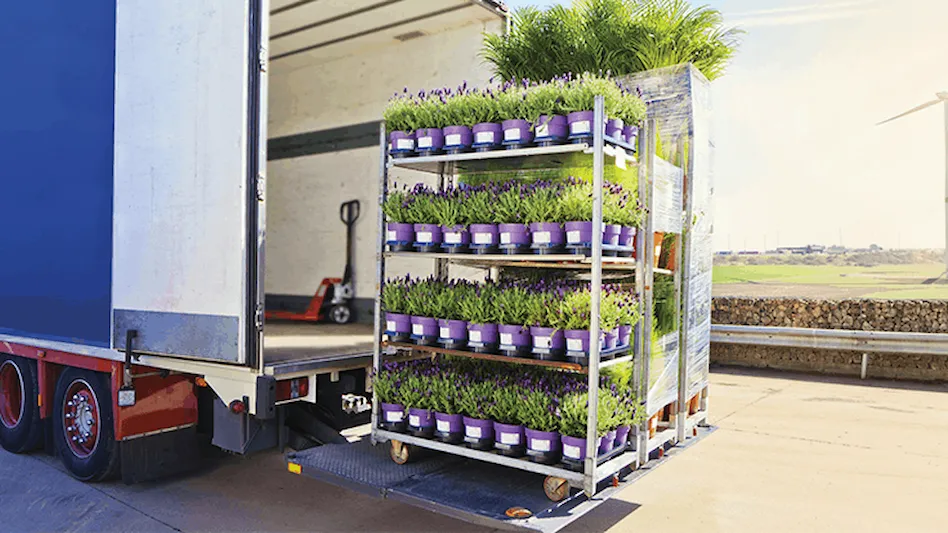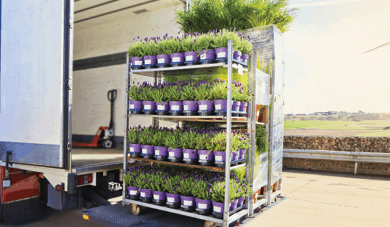

The idea of using GPS to find our way from A to B is still not very old. Most of us have had some interesting experiences with those early models, such as when my machine proudly declared that I was at my destination when I was actually sitting in the middle of six lanes of north Atlanta traffic. Fortunately, modern GPS is more accurate and can access real-time information about road restrictions, roadwork, accidents and other hazards. For most of us, these issues are inconvenient but to a trucking business, detours cost money and disgruntled customers.
Transporting live nursery material involves not just the best route for drivers, but the best times for plants to arrive when the retail operations can accept them. For decades, this task was done with pen and paper, which involved many hours of planning.
For Weatherford Farms in Stafford, Texas, co-owner Bridget Weatherford says the delivery schedules were previously set manually, and during busy holiday times, things got hectic — fully laden trucks had as many as 20 stops to make in the Houston area. Those days of manual planning came to an end when the grower switched to Paragon Software Systems, a routing and scheduling software program.
“Before we went to Paragon’s system, drivers complained about arriving at a site only to find another driver already there,” Weatherford says.
This is what truck route optimization is all about. It is a computer program that takes the real-time data for where and when delays are likely along a driver’s entire route, as well as the best truck route for each vehicle to take for deliveries. With this data input to the computer, the program delivers the route in minutes, not days. Some people talk about the route optimization programs as being the first major improvement to the trucking industry in many years.
Florida-based Costa Farms has several locations around the country where they grow tropical plants for the consumer market. The grower uses software from CACI Truckstops, helping them find routes for their trucks, which in the high season can number more than 200 trucks on the road at a time. Ryan MacFarland, Costa Farms’ vice president of supply chain management, says the optimization program found routes for all the trucks for three days in under 90 minutes.
Truck route optimization is typically a modular system that is installed on the site computer and designs routes that include all delivery points along with an assigned delivery time. The scheduling manager plugs in all the variable times and locations and gets a route that includes all those points, in minutes not hours. These routes can be printed for the driver or delivered via an app on their phone.

Adam Rowe, technology writer for Tech.co comments that KeepTruckin, another fleet management software company, “offers both hardware units and the software to go with them, including a manager dashboard and driver mobile app. KeepTruckin uses an open API for their software, ensuring that any third-party routing service can be integrated with the KeepTruckin dashboard.”
Willy Maurer, Costa Farms’ director of logistics, added that both software and updated driver information regarding problems is updated on the office computer and the driver’s module is updated before the next trip.
The nursery industry relies on having a great relationship with customers, which is tested at times when deliveries arrive at an unscheduled time and when staff cannot reasonably accept them. An irate customer relays their issues to the driver, which in turn makes that driver’s job satisfaction plummet. Truck route optimization allows wholesale operations to plug in multiple destinations along with preferred time for acceptance which, when met, is great for customer relations and increases the job satisfaction of the driver. This last point is important in an industry where turnover of drivers is high. According to the National Private Truck Council, driver retention is an important issue, so having routes that create happy customers and drivers that return home at a reasonable time is a benefit to everyone. Fewer miles travelled also makes your business more environmentally friendly.
Additionally, Pierre Netty at CACI Truckstops says that although most trucks are full of plants for each run, with traditional routing this can be as low as 60%, which wastes space. Often with the optimization, not only will the trucks arrive at the locations on time, but they can also make more stops which means the trucks can carry more plants per trip. Truckstops estimate that with proper routing, the fill rate rises from 65% to 95%.
Good software is carefully built to include industry best practices to ensure that drivers take sufficient breaks from the road and by January 2020, the ELD government mandate (Electronic Logging Device) will make sure that they do.
_(002)_fmt1.png)
“An ELD is a device that automatically records certain data elements at a set interval. These elements include date, location, time, engine hours and vehicle miles, as well as identification information for the driver, vehicle, authenticated user and motor carrier,” Rowe explains.
All optimization programs should already be linking directly to the ELD.
With a cyclical business like the green industry, many companies opt to hire the trucks and lease them by the day. The route that these trucks take and how long the lease lasts is a major investment each year. Having the trucks cover the distance efficiently and with fewer miles has a big impact on the bottom line of the business. Fortunately, most of the modern fleet trucks already have compatible systems so that your optimization program of choice will interface correctly.
Regarding the future of truck optimization programs, look for your ordering programs to be integrated with the truck optimization programs, says William Salter, managing director at Paragon Software Systems. This enables the trucks to be filled in the correct sequence for delivery without exceeding the weight limits. So, no more last-minute adjustments that delay the start of the trucks’ route.
For more: Paragon Software Systems, www.paragonrouting.com; CACI Truckstops, www.truckstopsrouting.com

Explore the December 2019 Issue
Check out more from this issue and find you next story to read.
Latest from Nursery Management
- Registration opens for Darwin Perennials Day
- April 2024 issue recap
- U.S. Department of Labor finalizes farmworker protection rule
- Azo Root is now available from Harrell’s
- Smith Gardens assumes operations of Skagit Horticulture
- Garden Media Group announces the fifth annual Women in Horticulture Week
- Eason Horticultural Resources announces the addition of Phil Perry
- Perennial Plant Association celebrates 40th anniversary





